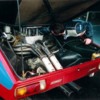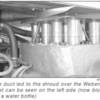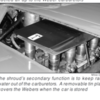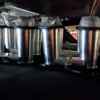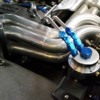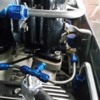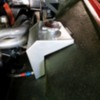What you can do (no one has yet) is take a piece of 1/4 lexan, bend it at about a 40 degree angle. Cut it to fit into the recess of the rear deck as an extended windshield. Attach it to the bottom of the sheet metal on the deck, where the hinges mount.
You have to play with the fit, the angle and the mounting BUT it would completely shield the carbs from the elements and it would open with the decklid.
I've been playing with this and went a slightly different route since I am working on a full set of deck louvres (like the Mind Train) and incorporated a smaller version.
The are molded rubber edgings that you could dress the edge of the lexan with. You don't need to make it air tight either.
In fact, it might be advantageous to leave a 1/2" to 1" opening around the perimeter?
Absolutely ANY covering or enclosure of the Webers will result in a big performance drop in HP.
If you look at the specs of even the wire mesh used to make the screens, the engineering numbers clearly state 46%. That's not a 46% reduction, the screen flows 46% of what the open stack does.
I am involved in something else at the moment but I am close to finalizing the velocity stacks and the carb covers.
My carbs in fact have .035" aluminum "roofs" built over the jet screens. I hear what you say on the stack heights but 5" spun aluminum is the way I am going to go. I do realize that #1 may need to be cut to fit against the glass?
There is a You Tube video of a Pantera in Japan running them and the stacks clearly clear the bulkhead glass window. So top me that is very encouraging.
In my case the louvres are interagal to the Weber intakes and they mount the lexan on the center structures.
Details, details. The Devil is in the details.
I like what you have done so far it looks great but I know that is a restrictive system.
I'm thinking that I need to protect the carbs from a "car wash" scenario. The benefit being that I won't need to worry about covering them to wash the car or worry about a friend filling the cylinders with hose water, washing the car, when he was just trying to help me out?

You and I are exactly at the same place right now although I am already resigned to the fact that I am going to look like a comp car, but that's ok with me.
None of the IDA should be left out exposed with no roof over it's head.
Look at what the GT40's did with this. They were covered with the plexiglass rear window, used an aluminum sheet metal cookie tray with o-rings around the velocity stacks, and fed them fresh air through the side roof scoops.


